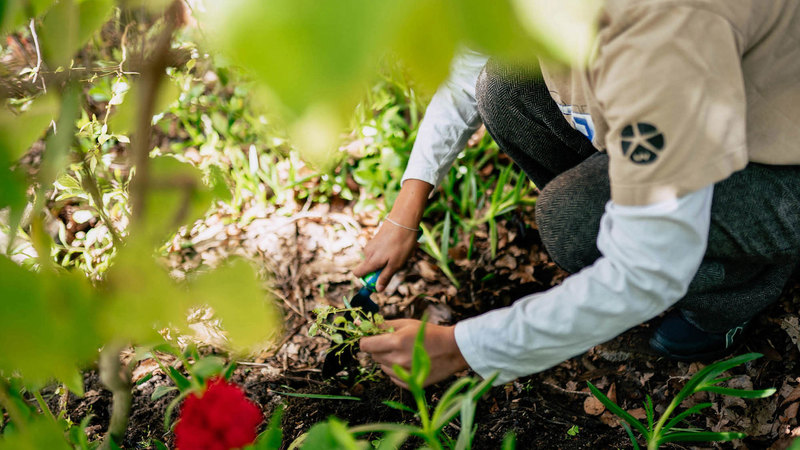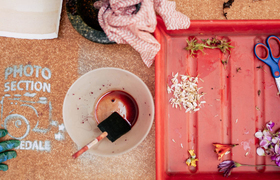Sustainable photographic garden explores innovative darkroom practices
26 October 2023 | Story Niémah Davids. Photos Robyn Walker. Videography Carbon Visuals & Supplied. Video Edit Ruairi Abrahams. VP Team Roxanne Harris, Ruairi Abrahams, Boikhutso Ntsoko and Rozanne Engel. Read time 8 min.An eco-conscious project that has high hopes of fast-tracking research in the field of sustainable photographic practices and cultivating a sense of environmental consciousness and agency among students and staff on campus has been on the go on a little compost patch at the University of Cape Town’s (UCT) Michaelis School of Fine Art (Michaelis).
The sustainable photographic garden explores new, innovative ways of working with darkroom-based photography, but the rule is clear: materials must be more environmentally friendly than traditional silver-based darkroom practices. The garden is used to gather plant material to investigate and enable new, sustainable ways of working in the field of photography, and is an initiative of Vanessa Cowling, a UCT alumnus and part-time member of staff at Michaelis; and the school’s Associate Professor Svea Josephy. The photographic garden is located on the Rosedale parking lot on UCT’s Hiddingh Campus, and second- and third-year photography students make use of the space.
“Our photographic garden has been set up to help us cause less environmental damage with the materials we use in our coursework.”
“Our photographic garden has been set up to help us cause less environmental damage with the materials we use in our coursework. It encourages the students to use plant materials [to create their work] and use everyday kitchen chemistry that’s non-toxic and doesn’t harm the environment. It’s also, very importantly, a communal teaching space that aims to move beyond material and towards investigating contexts and sites,” said Associate Professor Josephy.
The first phase
In 2017, when Cowling started teaching the earth politics project to second-year photography students, coming up with artistic responses to the looming environmental crisis was a requirement. As a result, students engaged in regular beach cleanups and learned about environmental destruction. But in 2020, at the onset of the COVID-19 pandemic, congregating in groups was no longer possible and learning to innovate was essential. By then, she said, students were also overwhelmed by the long list of challenges the environment faced, and starting a positive, environmentally sustainable initiative was the goal.
So, when Cowling started her master’s in fine art in 2021, and her academic programme placed a strong emphasis on sustainable photographic practices with plants as the focal point, the sustainable garden idea sprouted. And, in no time, it started to take shape, and the second-year class planted the first phase of the project. The garden is used to gather plant material for lumen prints (a simple way to make an image with the sun), anthotypes (an image created using photosensitive material from plants), and phytogram (an image created using the internal chemistry of plants to create visible chemical traces and marks on the photographic emulsion). Further, it’s also used as an environmentally friendly photographic developer, for water recycling and as a communal space.
What’s more, Josephy added, the space is also used to conduct research into the role indigenous South African plants play in sustainable darkroom practices, as well as conceptually, in artwork.
“We have gone through several attempts to shift our environmental footprint. And during the drought in 2017 and 2018, we became very conscious of our water consumption and began to wash our prints outdoors, so that the wastewater could be used to water the grass. We always wanted to do more, and because there’s little to no research on sustainable darkroom practices in South Africa, we could kill two birds with one stone with this project,” Josephy said.
Unique learning environment
But ultimately, the garden is a space for teaching and learning. And its primary goal is to teach and demonstrate to students that it’s possible to practise darkroom photography using sustainable resources. Above all, it also teaches them the practice of care.
“It’s also absolutely necessary that students, academics and all of humanity really start taking our current environmental crisis seriously.”
“This is an incredible project and it really is vital – in the full sense. It’s also absolutely necessary that students, academics and all of humanity really start taking our current environmental crisis seriously. And by starting small interventions like this one, that will lead to bigger movements, we are playing our part,” Cowling said.
She admitted that the idea was met with mild enthusiasm from some students and resistance from others. But over the past two years, students have grown to love the garden, respect its intended purpose and have enjoyed getting their hands dirty.
“In 2021, after a year of online teaching and learning, the yearning to connect physically with other students and the tangible substance of the earth was definitely there. And this seemed to have engendered an enthusiasm for the garden and gardening,” she said. “In the years that followed, we have noted that for some students, gardening comes naturally. But for others, being involved in our garden is the first time that they’ve deliberately put their hands in mud and had contact with the earth, and this is wonderful to witness.”
A one-of-a-kind space
The garden is believed to be the only one of its kind located at a South African university. But that’s just one of its unique elements. After much exploration, Josephy said they have now started growing indigenous South African plants – a high point for the garden because the Western Cape is one of only six floristic regions in the world. And although geographically it’s considered the smallest, it’s said to be the most biodiverse.
Given the opportunities in the region, Cowling and Josephy agreed that they are able to conduct unique research into sustainable darkroom practices and have already started exploring with fynbos and other indigenous plants to find smart ways of working with them in the darkroom.
“Initially, our aim was not to focus on indigenous plants, and so we used plants that we had researched that would produce strong colours for anthotypes. In 2021, we planted spinach, beetroot, nasturtiums, poppies, violets, geranium and mulberry and blackberry bush. But these were all relatively unsuccessful because of the lack of water during the summer, so we subsequently planted and started to experiment with indigenous South African plants and it’s all very exciting,” Cowling added.
It takes a community
But it is essential to ensure the garden’s longevity for years to come, and this requires invested community participation. Luckily, Josephy said, students and staff from other departments on Hiddingh Campus and their families have started to get involved. But additional volunteers are always welcome.
“Right now, each second-year student plants a spekboom cutting in a pot for the next year’s second-year cohort to plant out. In this way students also witness the importance of paying it forward,” Josephy said.
“The garden needs a community to help it survive. It needs to be watered in the summer and weeded in the winter.”
“But the garden needs a community to help it survive. It needs to be watered in the summer and weeded in the winter. Wood chip and compost also need to be laid down. We have done our best to create a community through our WhatsApp group and Instagram platform, which also raises awareness on the needs of the garden. But we do need more people to get involved.”
Projects that have inspired UCT’s sustainable photographic garden include the Northern Sustainable Darkroom – a research facility dedicated to sustainable photography based in Leeds, England; and The Sustainable Darkroom in London – a research group established under the London Alternative Photography Collective.
 This work is licensed under a Creative Commons Attribution-NoDerivatives 4.0 International License.
This work is licensed under a Creative Commons Attribution-NoDerivatives 4.0 International License.
Please view the republishing articles page for more information.
















